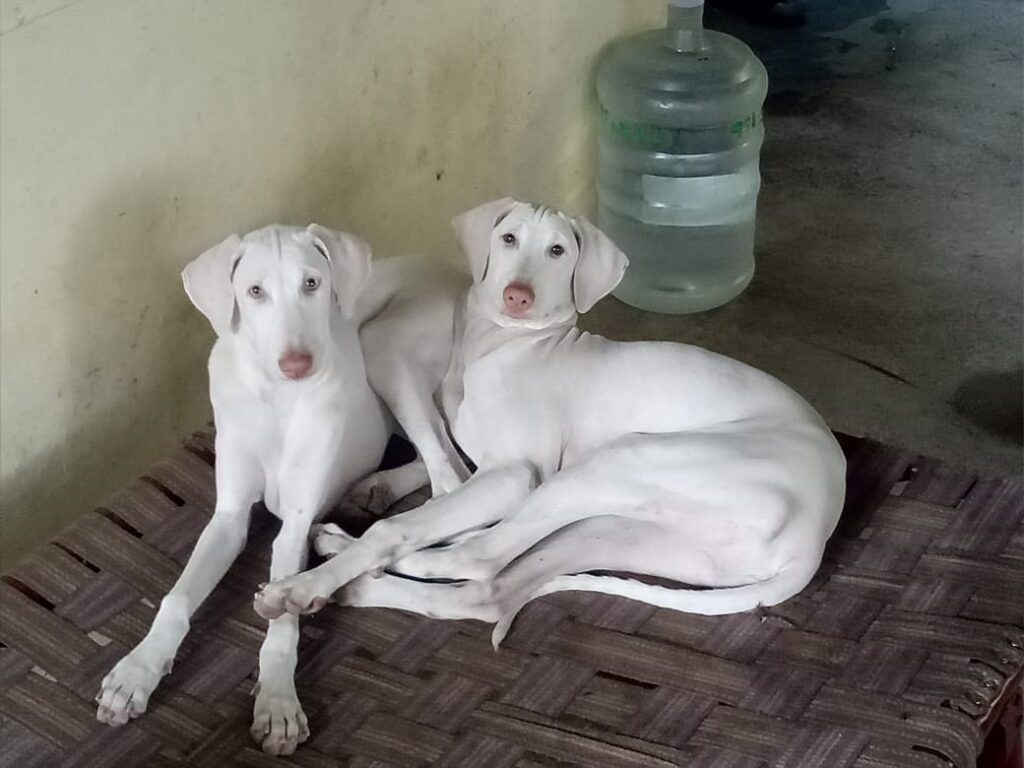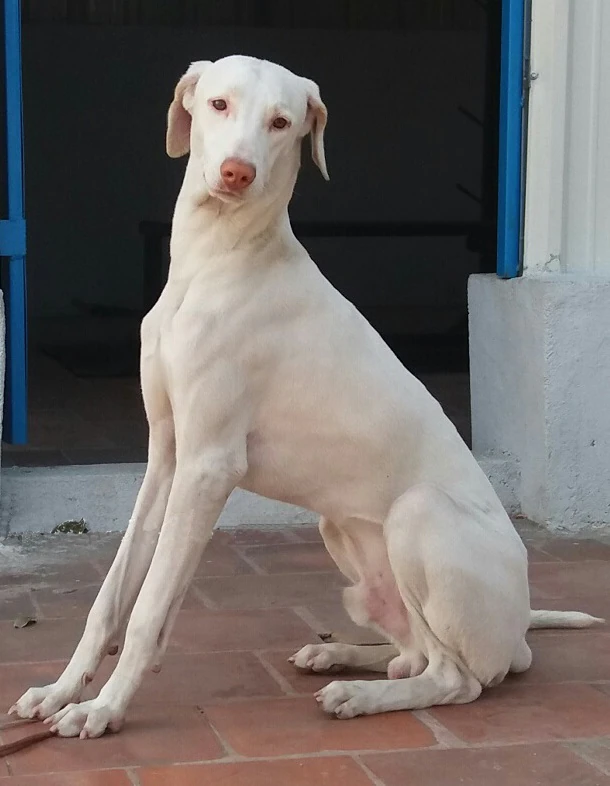இராசபாளையம் நாய் (Rajapalayam) History
இராசபாளையம் நாய்
தோன்றிய நாடு இந்தியா

இராஞபாளையம் நாய் ஆனது இந்திய வேட்டை நாய் வகையைச் சார்ந்தது ஆகும். முன்னைய நாட்களில் இந்நாய் ஆனது தென்னிந்தியாவில் இருந்த வசதி படைத்தோரிடமும் ஆளும் வர்க்கத்திடமுமே இருந்து வந்தது. குறிப்பாக இராசபாளையம் பகுதியில் மட்டுமே இது அதிகம் காணப்பட்டதால், இந்நாய் இப்பெயர் பெற்றது.
பெயராய்வு
இவ்வகை நாய்கள் பாளையக்காரர்களால் ஆந்திர, கர்நாடகப் பகுதிகளில் இருந்து கொண்டு வரப்பட்டதாகும். அங்கு இவ்வகை நாயினம் அழிந்துபோய் தமிழகத்தின் இராஜபாளையத்தில் மட்டும் எஞ்சியதால் இராஜபாளையம் நாய் என ஊர் பெயராலேயே அழைக்கப்பட்டது. இதை ஆங்கிலத்தில் பொலிகார் ஹவுண்ட் என்றும் அழைக்கப்படுகிறது. பாளையக்காரர்கள் (Poligar) பயன்படுத்தியதால், இந்த நாய்களின் மூதாதையர்களை துவக்கத்தில் பிரித்தானியர்களால் பொலிகார் ஹவுண்ட் என அழைக்கப்பட்டது.

வரலாறு
விஜயநகரப் பேரரசின் வருகையின்போது ஆந்திர, கர்நாடகப் பகுதியில் இருந்து தமிழகம் வந்த பாளையக்காரர்கள் மூலமாக தமிழகம் வந்த நாயாகும்.

தோற்றம்
இது ஒரு பெரிய நாயாகும். இது வெள்ளை நிற உடலும், இளஞ்சிவப்பு மூக்கும், மடிந்த காதுகளும் கொண்டிருக்கும். இது வழக்கமாக 65 முதல் 75 செ.மீ. (25-30 இன்ச்சுகள்) வரை, கிட்டத்தட்ட வெளிநாட்டு கிரேடனை ஒத்த தோற்றத்துடன், அதைவிடச் சற்றே குறைந்த உயரத்துடன் இருக்கும். இது ஒரு வேட்டை நாய் என்பதால் இதனை உகந்த வேலைகளுக்கு மட்டுமே ஈடுபடுத்த வேண்டும். இது பிற வேட்டை நாய்களைக் காட்டிலும், மிகவும் வலுவான எலும்புகளைக் கொண்டிருப்பினும் பிற குணங்களில் அனைத்துடனும் ஒத்துப் போகிறது.
இதன் முக அமைப்பு காரவன் வேட்டை நாய்களிடமிருந்து முழுதும் வேறுபட்டுள்ளது. இதன் வால் சிறிய வளைவைக் கொண்டுள்ளது. இப்பகுதியில் அதிகம் வாழும் ராஜகம்பளம் நாயக்கர் சமுதாயத்தினர் வேட்டையாடுவதை விருப்பமாக கொண்டுள்ளனர். இவர்கள் அதிகம் சிப்பிப்பாறை போன்ற பகுதிகளில் வாழ்கின்றனர். இவர்களே இந்தவகை நாய்களை அதிகம் வளர்த்து வருகின்றனர்.
வசதி படைத்தவர்களும் ஆட்சியிலிருப்போரும் வளர்த்தார்கள். விஜயநகரப் பேரரசின் வருகையின் போது பாளையக்காரர்கள் ஆந்திரா, கர்நாடகா பகுதியிலிருந்து கொண்டு வந்தார்கள்.பாளையக்காரர்கள்( Poligar) வளர்த்ததால் ஆங்கிலேயர்கள் இதை பொலிகார் ஹவுண்ட் என்றார்கள்.
அஞ்சல் தலை வெளியீடு
இந்தியத் தபால் தலை வெளியிடப்பட்ட நான்கு நாய்களில் ராஜபாளையமும் ஒன்று. மற்றநாய்களின் தபால்தலை மதிப்பு 5ரூபாய், இதன் மதிப்பு 15 ரூபாய். 2005 ஆம் ஆண்டு இந்திய அஞ்சல்தலையில் இடம்பெற்று பெருமைப்படுத்தப்பட்ட ஒரே தமிழக நாய் இனம், இராஜபாளையம் நாயாகும்.
History
The Rajapalayam, also known as the Polygar Hound, Shikkar Hound, or Indian Ghost Hound, is a southern Indian dog breed.The breed is named after Rajapalayam, a town in the Virudhunagar, Tamil Nadu.
Four commemorative postage stamps were issued on 9 January 2005 by India Post for four breeds: Himalayan Sheepdog, Rampur Hound, Mudhol Hound (Face value ₹ 5 each) and Rajapalayam (Face value ₹ 15). The Rajapalayam dog is known to live up to 12 years of age.

Appearance
It is a large dog, usually measuring about 65–75 cm (25–30 inches) at the withers and weighs 30 – 45 kg. Mostly found in the centre of Tamil nadu, the Rajapalayam was bred to be the complete hunter and estate guardian with features that allow it to excel. Primarily used to hunt wild boar independent of the handler, the Rajapalayam is unique in two ways. First, it fulfills the functions of a bay dog as well as a catch dog; secondly the Rajapalayam can hunt by sight as well as track by scent. While hunting they can be relentless pursuers that are not intimidated by complex terrain or bodies of water. After finding their prey, the dogs take it down and bring it back to the handler. If the dog is unable to bring down its prey, it injures and corners the target till the handler can get to it. This dog can hunt alone, in pairs, in a pack, or with its owner.
Rajapalayams tend to be more muscular and heavier boned than most sighthounds, but they share the deep chest and basic body structure that exudes speed and physical ability. Its facial structure is considerably different from that of a Caravan Hound, with a slightly larger head and more powerful jaws. It has a slightly curled tail.
An extremely handsome and graceful dog, the Rajapalayam has a double suspension gait, similar to the trotting of a thoroughbred horse. The staple colour is milk white, although faint brown markings are quite common, and the pink nose is standard.
Eye color can range from golden to brown and green. Puppies born with whitish or blue eyes are usually deaf and should not be bred. The coat is single, short, and fine; these dogs don’t do well in very cold climates, but excel in the heat of South India or tropics.
While many Rajapalayam dogs suffer from mange, it rarely is serious, as mange is actually caused by mites, so it is basically a matter of preventing mites rather than a breed issue. Otherwise, the breed is robust and low-maintenance.
Rajapalayam dogs have a pink nose, button ears, whiptail and golden eyes. They have a gait similar to that of a horse and were also used during the Carnatic Wars and Polygar war against the British cavalry. They aren’t fast runners, but are tireless and steady over long distances. There were reports that the Indian Army in Kashmir had them as guard dogs.
Future of the breed
The pure Rajapalayam used to only be found in isolated pockets around southern Tamil Nadu. A dog breeding unit was established at Saidapet, Chennai, during 1980–81. This unit primarily rears native breeds such as the Rajapalayam dog, Combai dog, kanni, and Chippiparai.To create awareness and encourage dog lovers to rear native breeds, the Animal Husbandry Department of the Government of Tamil Nadu participates in dog shows. Localities have established a cooperative, and interested families receive female dogs and the expertise that is required for large-scale breeding. The Indian Postal Department has brought out postage stamps on the Rajapalayam dog breed,as well as the Mudhol Hound, Rampur Hound, and the Himalayan Sheepdog. The Kennel Club of India has taken up the cause of the Rajapalayam. With the club’s cooperation, the “Save the Rajapalayam Project” has been launched. These initiatives have successfully brought the breed back from the brink of extinction.
It is important to research properly before purchasing or adopting a puppy, because many unethical breeders are giving customers inbred and genetically compromised puppies.




